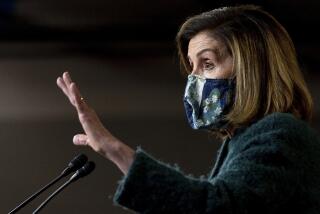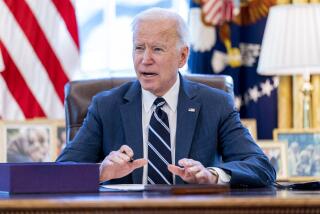Japan Unveils $142-Billion Plan to Spark Its Economy : Asia: Record package includes public works spending and land purchases. The dollar rises to 15-month high.
- Share via
TOKYO — Prime Minister Tomiichi Murayama’s government today unveiled the biggest pump-priming package in Japan’s history, a $142.2-billion program aimed at resuscitating an economy that has remained stagnant for nearly four years.
The higher-than-expected outlay, described as the total monetary impact expected on the economy from new measures the government said it will implement, is equal to more than 3.3% of Japan’s real gross domestic product.
The Asahi newspaper estimated the amount of actual money being added to the budgets of national and local governments at $80 billion.
Early reports of the size of the stimulus package drove the dollar to a 15-month high of 104.63 yen in late New York trading Tuesday, but it had eased slightly to 104.35 yen by midday Wednesday in Tokyo. Higher government spending would put more yen into circulation, weakening the Japanese currency and helping Japan’s export industries.
In Tokyo, investors’ initial response to published reports of the government’s plan was mixed. After an initial surge, the Nikkei-225 stock index was off 99.37 points to 18,375.01 at midday Wednesday in Tokyo.
Satoshi Nojiri of the Yamaichi Securities Economic Research Institute said the package was “larger than I had expected.” He predicted it would stimulate an extra 1% of real growth over 12 months, and a half-percent during fiscal 1995, which ends March 31, 1996.
But Nojiri and other economists criticized the measures as failing to tackle the underlying structural problems in the economy.
Robert Feldman, an economist at Salomon Bros., characterized the package as “a lot of sugar and not much protein.”
“The package is very heavy on public works, light on housing, and heavy on agricultural subsidies,” but short on structural reforms, Feldman said. Thus the economic impact “will run out when the money runs out--in about a year. That’s why it’s all sugar,” he added.
Mineko Sasaki-Smith, economist at Morgan Stanley, noted that the stimulus program “does not deal with the non-performing loans, and it does not deal with excess capacity in manufacturing, or the financial sector.”
Included in the government’s overall figure of $142.2 billion were a program of $46 billion in public works spending and a pledge for $32 billion in government purchases of land for future projects.
The land purchases were aimed at revitalizing a real estate market in which business-property transactions have ground to a halt. This has paralyzed efforts by banks to unload properties they hold as collateral for an estimated $500 billion worth of bad loans.
No direct measures were announced to help the banks dispose of such loans. But the government promised to come up with specific rescue actions by the end of the year.
The package allocates another $14 billion for reconstruction of the earthquake-devastated Kobe region, bringing total central government allocations for cleanup and repair of damage from the Jan. 17 disaster to $39 billion.
Farmers facing competition from limited imports of rice and lower tariffs on other agricultural goods after the Uruguay Round of trade liberalization were promised $11 billion in subsidies.
The announcement also listed programs to ease government regulation and open the doors to new economic activity.
Even before the package was announced, Isamu Miyazaki, director of the Economic Planning Agency, warned that the government must still offer a convincing scenario for a midterm outlook for economic recovery and compile a stimulative budget for 1996 to ensure that the package will have a significant effect on the economy.
The banks’ bad loan problems also must be solved before a full recovery can occur, he said.
A week ago, Miyazaki declared that he will resign if the program fails to spur growth.
Also at stake is the government’s credibility in economic management. Since 1991, Japanese governments have announced five pump-priming packages worth more than $400 billion. But the economy failed to exceed 0.6% real growth in any of the last three years--the first time Japan has experienced prolonged stagnation since the end of World War II.
Moreover, statistics show that no substantial increase occurred in public works spending in fiscal 1994, despite the government’s claim that it had boosted such spending by more than $100 billion during that year.
On Monday, the Economic Planning Agency announced that the economy grew at an annual rate of 3.1% between April and June, an unexpected upturn after declining between January and March.
Tsuyoshi Kanno of the Yasuda Research Institute predicted the economy will grow just 1% this year. “Without the package, the economy probably would not grow at all, or decline, this year.”
More to Read
Sign up for Essential California
The most important California stories and recommendations in your inbox every morning.
You may occasionally receive promotional content from the Los Angeles Times.













